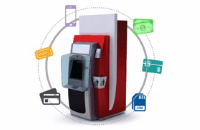Social media has completely revamped how we interact with our social circles, without the inconvenience and cost of traditional socialization. What was invented as a supplement to our day to day interactions has now become the norm. Social media now connects us daily with people around and those away from us. The popularity of Facebook, in particular, can be accredited with initiating this movement. We can now interact with a lot more people, apply for more jobs, buy more items in less time with better product comparison, or even run an entire business from a social media web front. It has been a rapidly evolving phenomenon that is only set to dominate greater segments of our lives.
Social Media Usage
According to ‘We are Social’, there are about 7.395 billion humans out of which 2.307 billion actively use social media. A growth rate of 46% was recorded this year, adding 219 million new active social media users since 2015. From Argentina to Vietnam, the survey involved 30 developed and underdeveloped countries. Facebook, with over 1500 million users secured first position among the most followed social networking websites on the globe.
The aforementioned data shows the importance of social media integration for businesses. Social media gives an additional venue to merchants where they can market their products. They can even reach out to customers who are otherwise beyond their reach. Marketing content on famous social platforms like Facebook and Twitter can boost the sales up to 70% if utilized smartly.
Targeting Millennials
Financial Institutions are directly or indirectly associated with the lives of a huge population either professionally or personally. It has now become the need of the time that the payment industry catches up to the imminent trends leading to a comprehensive social banking ecosystem. According to World Retail Banking Report 2015, 56% of the banks world-wide are still in the process of gathering information as to how can social banking be a part of the conventional banking without affecting the existing consumer base.
When targeting social media in future prospects, banks should also consider the fact that millennials (people born between 1980s and 2000s) are the generation that are a predominant segment of the social cloth. On every popular social website, millennials are actively participating in bigger numbers than generation X (people born before 1980). As they are more enthusiastic about social media, the demands and expectations also point towards a better, innovative and technologically diversified banking arena where they do not need to walk to a financial institution’s physical branch for regular transactions. The report also highlighted the possibility of millennials leaving their primary banks in the next 6 months due to the unavailability of banking options that involve social media as compared to generation X.
Financial barriers, security concerns and legal implications can be the underlined constraints that banks could face in the way of integrating social banking. At some level, these concerns are legitimate and demand a divergent analysis of the current and future aspects. For any organisation, adapting new technology and working in a completely different environment are not easy tasks to achieve. In order to begin with social banking, banks first need to take a number of steps, starting with increasing social presence and then moving on to the development of social banking features.
Social Payments
Banks can put their first footstep in social banking by introducing basic functionalities on social media. These functionalities may not require several levels of encryption. Initially, a bank can only facilitate customers in viewing their balance on any social media platform. Customers would also be able to view mini statement or request for a new card. Once the customers become accustomed to these features and get over the initial fear of security, banks can start introducing many innovative functionalities, the likes of which will redefine banking as we know it now.
Having gained the confidence of their customers, banks can now launch features like transferring funds to friends through Facebook or Twitter; without knowing their account details, requesting money from friends or collecting funds for a social cause. All of these innovations use a key feature of social media which involves a person’s social connections.
On the other hand, online shopping has took a turn with social media, where merchants; small or large, showcase their products. The only ingredient missing is enabling customers to make payments directly from these platforms, where they can see the product, instead of elongating the process by asking customers to make a separate fund transfer to merchant’s account; a cumbersome process that customers today follow grudgingly because of lack of other options. Allowing customers to make payments through social media will make life easier for customers. It will also help merchants in retaining and gaining more customers.
These are just some future projections of how banks can attract new customers. Rest assured, only the banks which embrace social media today will survive this race of innovation. Today, people literally live on social media, then why don’t banks do the same?
TPS’s Role In Social Banking
TPS, with their goal of bringing the best and the most innovative to its customers, has now entered the arena of social banking, with prominent developments in two of its major products PRISM and Payaxis.
PRISM internet banking solution has been working to bring versatile eBanking features for the industry. PRISM has now taken on a new turn by introducing applications for both Facebook and Twitter.
Similarly Payaxis has features carefully designed keeping in mind the current market trends and consumer needs. TPS envisions it as a reliable payment gateway that can help increase user acceptance as well as merchant ease. With hashtag payments for Twitter, Payaxis has transcended one more milestone of providing diverse payment options to its customers. At the same time, Payaxis’s module of Facebook payments, enables merchants to market their products on Facebook and also receive payment using the same platform.
Disclaimer: This post originally appeared in Business Recorder.










Leave A Comment